SpoVG Is Necessary for Sporulation in Bacillus anthracis
Abstract
1. Introduction
2. Materials and Methods
2.1. Strain Construction and Growth Conditions
2.2. Assay of Spore Formation Rate
2.3. Analysis of Sporulation Using Microscopy
2.4. β-Galactosidase Activity Assay
2.5. RNA Isolation and Reverse Transcription Real-Time Quantitative PCR (RT-qPCR)
2.6. Ultrastructural Studies of Sporulation Using Transmission Electron Microscopy (TEM)
2.7. Evaluation of Heat Resistance on LB-Agar Medium
2.8. Phylogenetic Analysis
2.9. Confocal Laser-Scanning Microscopy
3. Results
3.1. Deletion of spoVG Results in a Spore Formation Defect in B. anthracis
3.2. Deletion of spoVG Resulted in a Complete Blockage Prior to Asymmetric Division in B. anthracis
3.3. SpoIIB is Poorly Conserved Between B. anthracis and B. subtilis
3.4. SpoIIBBs Could Not Restore the ΔspoVG Strain to Mature Resistant Spores
3.5. SpoIIBBs Partially Restored Sporulation of ΔspoVG at the Engulfment Stage
4. Discussion
5. Conclusions
Supplementary Materials
Author Contributions
Funding
Acknowledgments
Conflicts of Interest
References
- Hagan, A.K.; Plotnick, Y.M.; Dingle, R.E.; Mendel, Z.I.; Cendrowski, S.R.; Sherman, D.H.; Tripathi, A.; Hanna, P.C. Petrobactin Protects against Oxidative Stress and Enhances Sporulation Efficiency in Bacillus anthracis Sterne. mBio 2018, 9. [Google Scholar] [CrossRef] [PubMed]
- Tan, I.S.; Ramamurthi, K.S. Spore formation in Bacillus subtilis. Environ. Microbiol. Rep. 2014, 6, 212–225. [Google Scholar] [CrossRef] [PubMed]
- Piggot, P.J.; Coote, J.G. Genetic aspects of bacterial endospore formation. Bacteriol. Rev. 1976, 40, 908–962. [Google Scholar] [CrossRef] [PubMed]
- Stragier, P.; Losick, R. Molecular genetics of sporulation in Bacillus subtilis. Annu. Rev. Genet. 1996, 30, 297–341. [Google Scholar] [CrossRef]
- Margolis, P.S.; Driks, A.; Losick, R. Sporulation gene spoIIB from Bacillus subtilis. J. Bacteriol. 1993, 175, 528–540. [Google Scholar] [CrossRef]
- Wilkinson, B.J.; Deans, J.A.; Ellar, D.J. Biochemical evidence for the reversed polarity of the outer membrane of the bacterial forespore. Biochem. J. 1975, 152, 561–569. [Google Scholar] [CrossRef]
- Matsuno, K.; Sonenshein, A.L. Role of SpoVG in asymmetric septation in Bacillus subtilis. J. Bacteriol. 1999, 181, 3392–3401. [Google Scholar] [CrossRef]
- Barak, I.; Muchova, K.; Labajova, N. Asymmetric cell division during Bacillus subtilis sporulation. Future Microbiol. 2019, 14, 353–363. [Google Scholar] [CrossRef]
- Feucht, A.; Abbotts, L.; Errington, J. The cell differentiation protein SpoIIE contains a regulatory site that controls its phosphatase activity in response to asymmetric septation. Mol. Microbiol. 2002, 45, 1119–1130. [Google Scholar] [CrossRef]
- Smith, K.; Youngman, P. Evidence that the spoIIM gene of Bacillus subtilis is transcribed by RNA polymerase associated with sigma E. J. Bacteriol. 1993, 175, 3618–3627. [Google Scholar] [CrossRef] [PubMed][Green Version]
- Londono-Vallejo, J.A.; Frehel, C.; Stragier, P. SpoIIQ, a forespore-expressed gene required for engulfment in Bacillus subtilis. Mol. Microbiol. 1997, 24, 29–39. [Google Scholar] [CrossRef] [PubMed]
- Costa, T.; Serrano, M.; Steil, L.; Volker, U.; Moran, C.P., Jr.; Henriques, A.O. The timing of cotE expression affects Bacillus subtilis spore coat morphology but not lysozyme resistance. J. Bacteriol. 2007, 189, 2401–2410. [Google Scholar] [CrossRef] [PubMed]
- Boone, T.J.; Mallozzi, M.; Nelson, A.; Thompson, B.; Khemmani, M.; Lehmann, D.; Dunkle, A.; Hoeprich, P.; Rasley, A.; Stewart, G.; et al. Coordinated Assembly of the Bacillus anthracis Coat and Exosporium during Bacterial Spore Outer Layer Formation. mBio 2018, 9. [Google Scholar] [CrossRef] [PubMed]
- Mattoo, A.R.; Saif Zaman, M.; Dubey, G.P.; Arora, A.; Narayan, A.; Jailkhani, N.; Rathore, K.; Maiti, S.; Singh, Y. Spo0B of Bacillus anthracis—A protein with pleiotropic functions. FEBS J. 2008, 275, 739–752. [Google Scholar] [CrossRef]
- Perez, A.R.; Abanes-De Mello, A.; Pogliano, K. SpoIIB localizes to active sites of septal biogenesis and spatially regulates septal thinning during engulfment in bacillus subtilis. J. Bacteriol. 2000, 182, 1096–1108. [Google Scholar] [CrossRef]
- Rosenbluh, A.; Banner, C.D.; Losick, R.; Fitz-James, P.C. Identification of a new developmental locus in Bacillus subtilis by construction of a deletion mutation in a cloned gene under sporulation control. J. Bacteriol. 1981, 148, 341–351. [Google Scholar] [CrossRef]
- Pan, X.; Chen, X.; Su, X.; Feng, Y.; Tao, Y.; Dong, Z. Involvement of SpoVG in hemolysis caused by Bacillus subtilis. Biochem. Biophys. Res. Commun. 2014, 443, 899–904. [Google Scholar] [CrossRef]
- Aung, S.; Shum, J.; Abanes-De Mello, A.; Broder, D.H.; Fredlund-Gutierrez, J.; Chiba, S.; Pogliano, K. Dual localization pathways for the engulfment proteins during Bacillus subtilis sporulation. Mol. Microbiol. 2007, 65, 1534–1546. [Google Scholar] [CrossRef]
- Liu, X.; Wang, D.; Ren, J.; Tong, C.; Feng, E.; Wang, X.; Zhu, L.; Wang, H. Identification of the immunogenic spore and vegetative proteins of Bacillus anthracis vaccine strain A16R. PLoS ONE 2013, 8, e57959. [Google Scholar] [CrossRef]
- Chastanet, A.; Losick, R. Engulfment during sporulation in Bacillus subtilis is governed by a multi-protein complex containing tandemly acting autolysins. Mol. Microbiol. 2007, 64, 139–152. [Google Scholar] [CrossRef]
- Lyu, Y.; Gu, M.; Chen, M.; Feng, E.; Zhu, L.; Pan, C.; Wang, D.; Liu, X.; Wang, H. Disruption of SpoIIID decreases sporulation, increases extracellular proteolytic activity and virulence in Bacillus anthracis. Biochem. Biophys. Res. Commun. 2019, 513, 651–656. [Google Scholar] [CrossRef] [PubMed]
- Arantes, O.; Lereclus, D. Construction of cloning vectors for Bacillus thuringiensis. Gene 1991, 108, 115–119. [Google Scholar] [CrossRef]
- Peng, Q.; Wu, J.; Chen, X.; Qiu, L.; Zhang, J.; Tian, H.; Song, F. Disruption of Two-component System LytSR Affects Forespore Engulfment in Bacillus thuringiensis. Front. Cell. Infect. Microbiol. 2017, 7, 468. [Google Scholar] [CrossRef] [PubMed]
- Wang, T.; Wang, D.; Lyu, Y.; Feng, E.; Zhu, L.; Liu, C.; Wang, Y.; Liu, X.; Wang, H. Construction of a high-efficiency cloning system using the Golden Gate method and I-SceI endonuclease for targeted gene replacement in Bacillus anthracis. J. Biotechnol. 2018, 271, 8–16. [Google Scholar] [CrossRef]
- Zuber, P.; Healy, J.M.; Losick, R. Effects of plasmid propagation of a sporulation promoter on promoter utilization and sporulation in Bacillus subtilis. J. Bacteriol. 1987, 169, 461–469. [Google Scholar] [CrossRef]
- Shatalin, K.Y.; Neyfakh, A.A. Efficient gene inactivation in Bacillus anthracis. FEMS Microbiol. Lett. 2005, 245, 315–319. [Google Scholar] [CrossRef] [PubMed]
- Grossman, A.D.; Losick, R. Extracellular control of spore formation in Bacillus subtilis. Proc. Natl. Acad. Sci. USA 1988, 85, 4369–4373. [Google Scholar] [CrossRef] [PubMed]
- Perchat, S.; Dubois, T.; Zouhir, S.; Gominet, M.; Poncet, S.; Lemy, C.; Aumont-Nicaise, M.; Deutscher, J.; Gohar, M.; Nessler, S.; et al. A cell-cell communication system regulates protease production during sporulation in bacteria of the Bacillus cereus group. Mol. Microbiol. 2011, 82, 619–633. [Google Scholar] [CrossRef] [PubMed]
- Peng, Q.; Kao, G.; Qu, N.; Zhang, J.; Li, J.; Song, F. The Regulation of Exosporium-Related Genes in Bacillus thuringiensis. Sci. Rep. 2016, 6, 19005. [Google Scholar] [CrossRef]
- Ter Beek, A.; Keijser, B.J.; Boorsma, A.; Zakrzewska, A.; Orij, R.; Smits, G.J.; Brul, S. Transcriptome analysis of sorbic acid-stressed Bacillus subtilis reveals a nutrient limitation response and indicates plasma membrane remodeling. J. Bacteriol. 2008, 190, 1751–1761. [Google Scholar] [CrossRef]
- Liszewski Zilla, M.; Lunderberg, J.M.; Schneewind, O.; Missiakas, D. Bacillus anthracis lcp Genes Support Vegetative Growth, Envelope Assembly, and Spore Formation. J. Bacteriol. 2015, 197, 3731–3741. [Google Scholar] [CrossRef] [PubMed]
- Jones, J.H.; Lennard-Jones, J.E.; Morson, B.C.; Chapman, M.; Sackin, M.J.; Sneath, P.H.; Spicer, C.C.; Card, W.I. Numerical taxonomy and discriminant analysis applied to non-specific colitis. Q. J. Med. 1973, 42, 715–732. [Google Scholar] [PubMed]
- Kumar, S.; Stecher, G.; Li, M.; Knyaz, C.; Tamura, K. MEGA X: Molecular Evolutionary Genetics Analysis across Computing Platforms. Mol. Biol. Evol. 2018, 35, 1547–1549. [Google Scholar] [CrossRef] [PubMed]
- Bradshaw, N.; Losick, R. Asymmetric division triggers cell-specific gene expression through coupled capture and stabilization of a phosphatase. eLife 2015, 4, e08145. [Google Scholar] [CrossRef] [PubMed]
- Skoble, J.; Beaber, J.W.; Gao, Y.; Lovchik, J.A.; Sower, L.E.; Liu, W.; Luckett, W.; Peterson, J.W.; Calendar, R.; Portnoy, D.A.; et al. Killed but metabolically active Bacillus anthracis vaccines induce broad and protective immunity against anthrax. Infect. Immun. 2009, 77, 1649–1663. [Google Scholar] [CrossRef]
- Cardoso, P.F.; Perchat, S.; Vilas-Boas, L.A.; Lereclus, D.; Vilas-Boas, G.T. Diversity of the Rap-Phr quorum-sensing systems in the Bacillus cereus group. Curr. Genet. 2019, 65, 1367–1381. [Google Scholar] [CrossRef]
- Bi, C.; Jones, S.W.; Hess, D.R.; Tracy, B.P.; Papoutsakis, E.T. SpoIIE is necessary for asymmetric division, sporulation, and expression of sigmaF, sigmaE, and sigmaG but does not control solvent production in Clostridium acetobutylicum ATCC 824. J. Bacteriol. 2011, 193, 5130–5137. [Google Scholar] [CrossRef]
- Levdikov, V.M.; Blagova, E.V.; Rawlings, A.E.; Jameson, K.; Tunaley, J.; Hart, D.J.; Barak, I.; Wilkinson, A.J. Structure of the phosphatase domain of the cell fate determinant SpoIIE from Bacillus subtilis. J. Mol. Biol. 2012, 415, 343–358. [Google Scholar] [CrossRef]
- Resnekov, O.; Driks, A.; Losick, R. Identification and characterization of sporulation gene spoVS from Bacillus subtilis. J. Bacteriol. 1995, 177, 5628–5635. [Google Scholar] [CrossRef][Green Version]
- Smith, K.; Bayer, M.E.; Youngman, P. Physical and functional characterization of the Bacillus subtilis spoIIM gene. J. Bacteriol. 1993, 175, 3607–3617. [Google Scholar] [CrossRef][Green Version]
- Bressuire-Isoard, C.; Bornard, I.; Henriques, A.O.; Carlin, F.; Broussolle, V. Sporulation Temperature Reveals a Requirement for CotE in the Assembly of both the Coat and Exosporium Layers of Bacillus cereus Spores. Appl. Environ. Microbiol. 2016, 82, 232–243. [Google Scholar] [CrossRef] [PubMed]
- Giorno, R.; Bozue, J.; Cote, C.; Wenzel, T.; Moody, K.S.; Mallozzi, M.; Ryan, M.; Wang, R.; Zielke, R.; Maddock, J.R.; et al. Morphogenesis of the Bacillus anthracis spore. J. Bacteriol. 2007, 189, 691–705. [Google Scholar] [CrossRef] [PubMed]

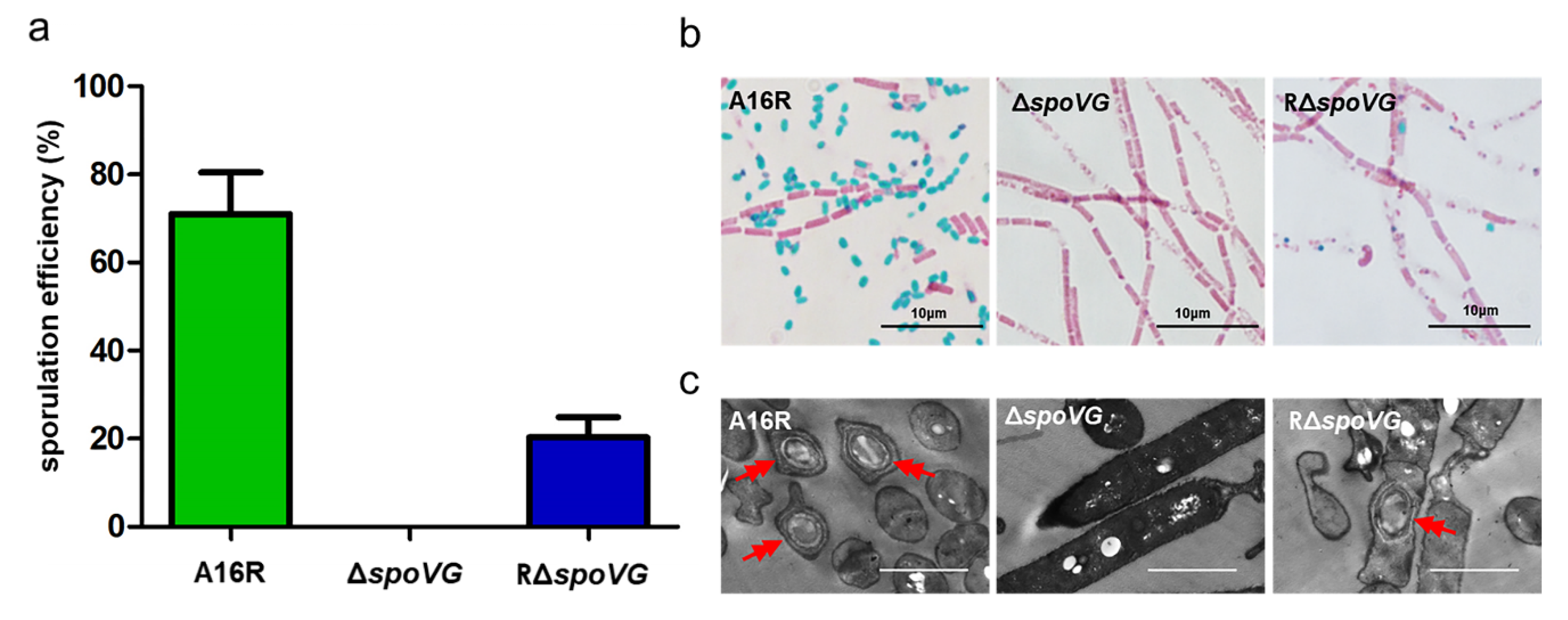
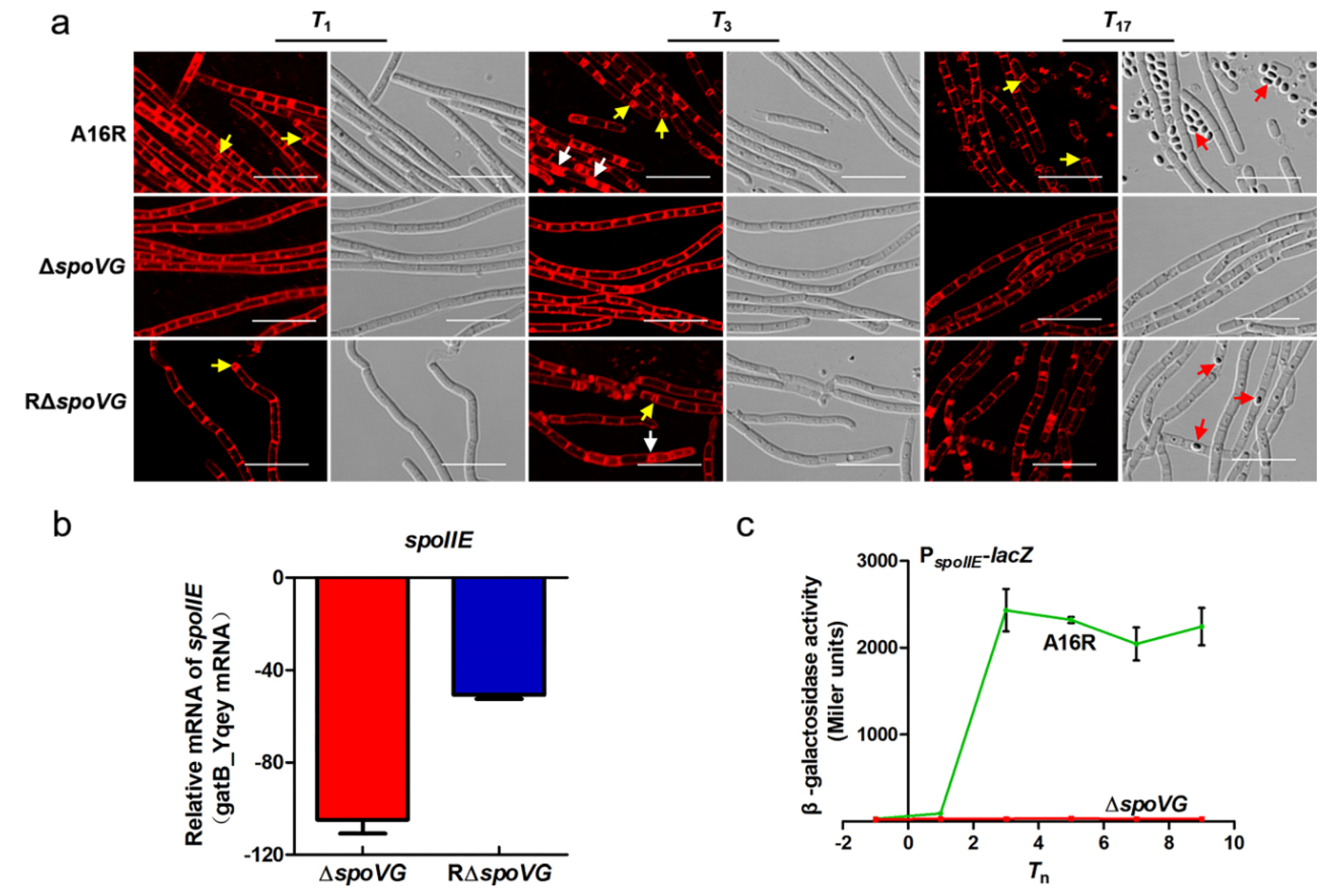
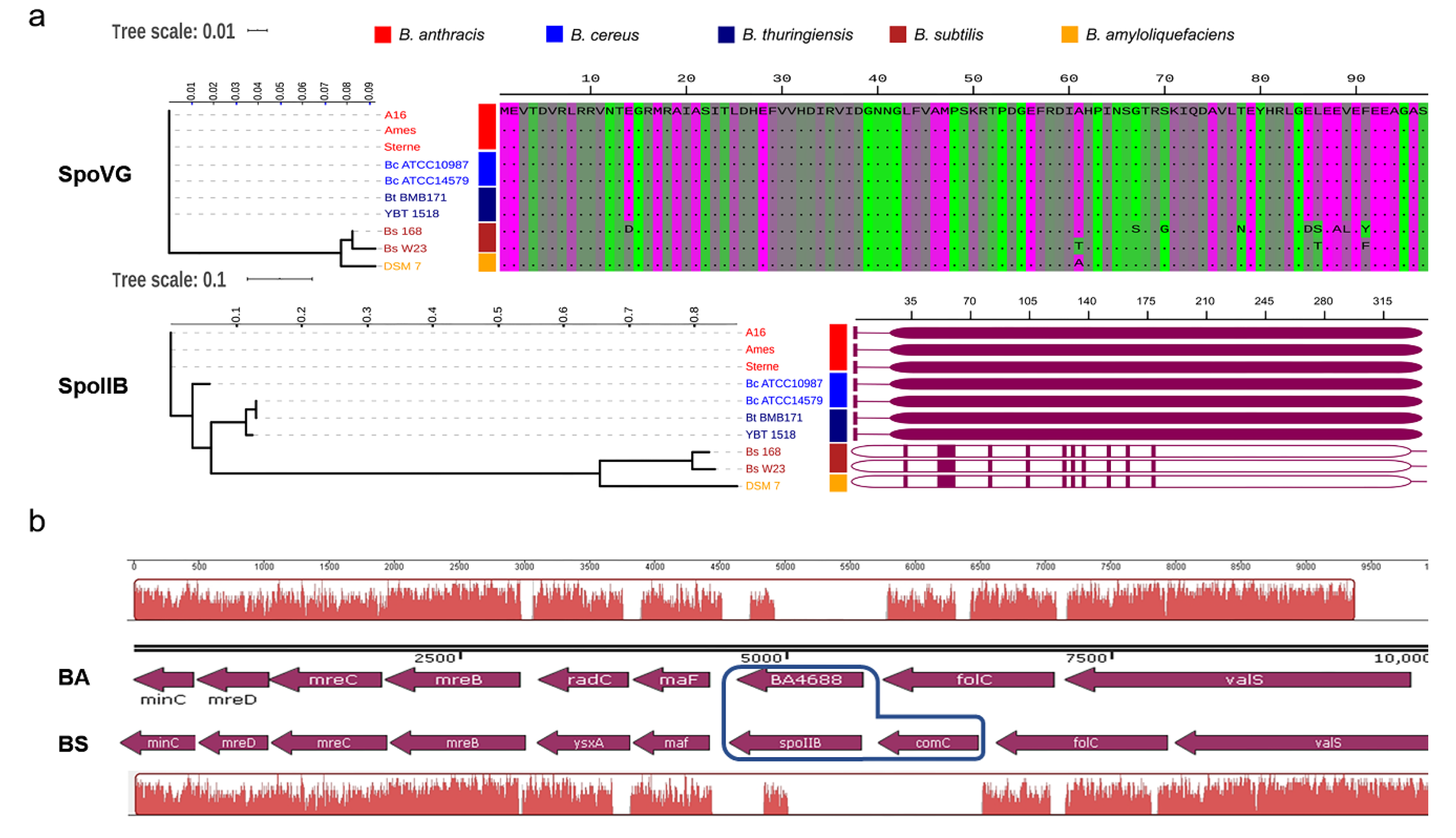
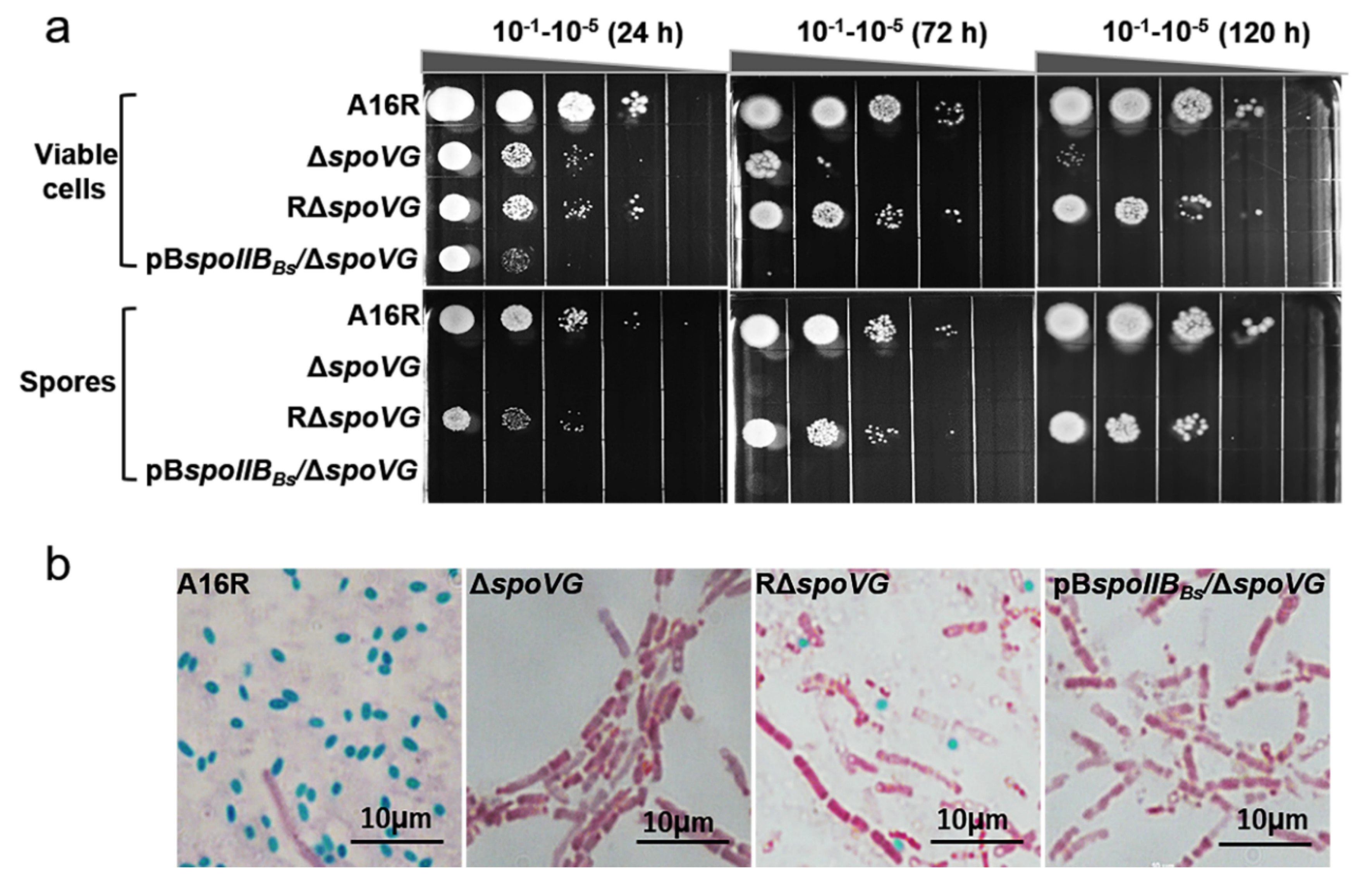
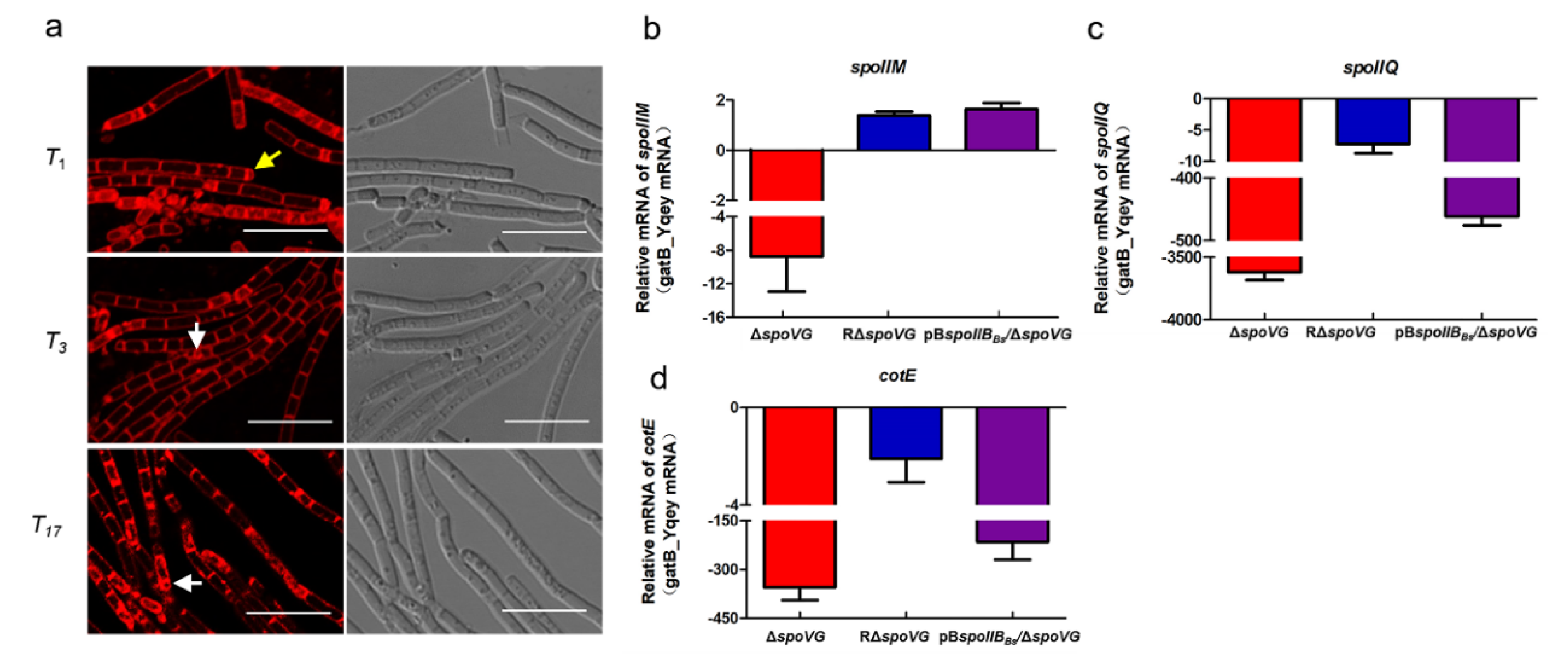
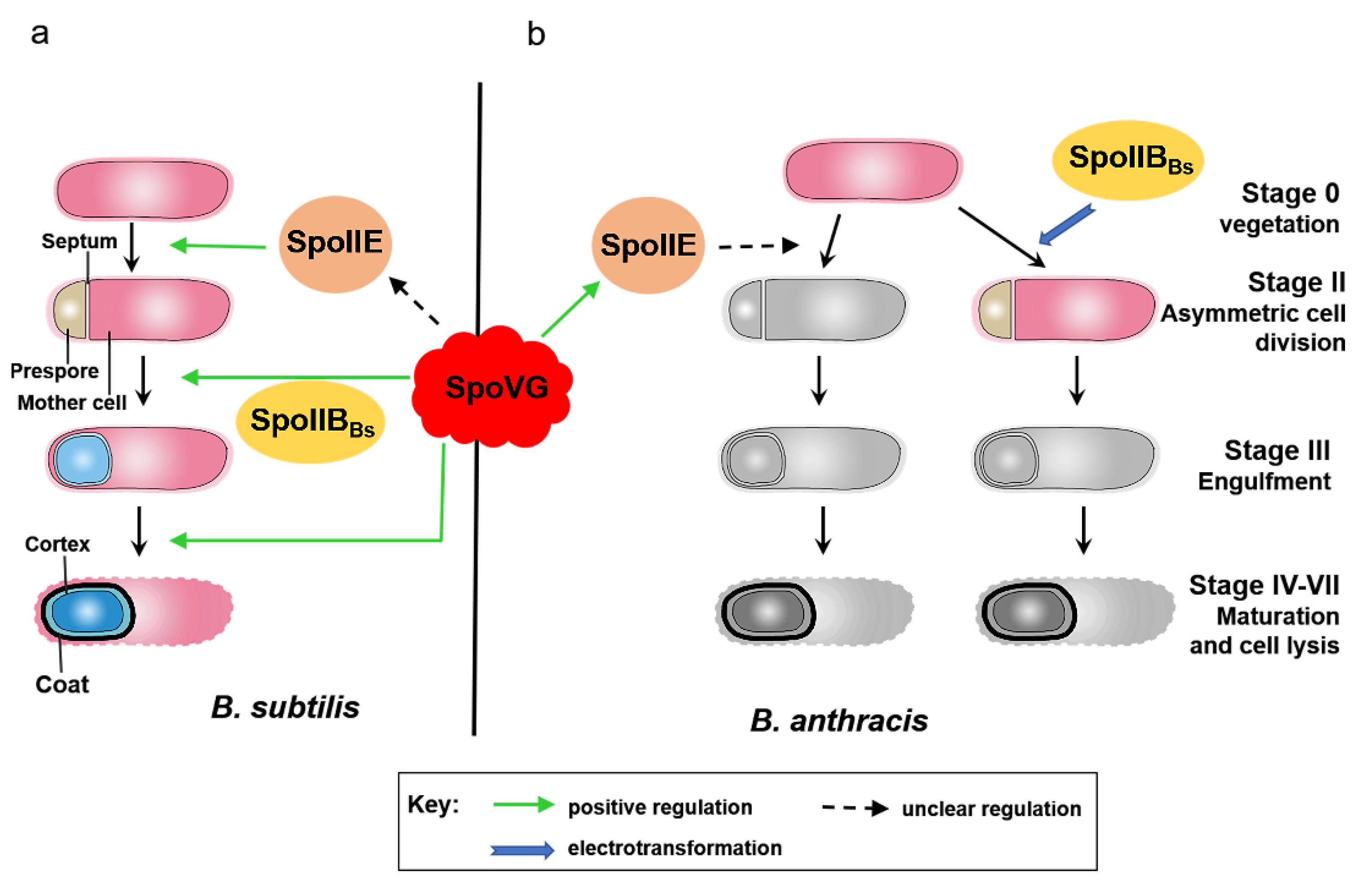
| Plasmid or Strain | Genotype or Description | Source |
|---|---|---|
| Plasmid | ||
| pBE2A | Shuttle vector containing amylase promoter, Kanr in B. anthracis and Ampr in Escherichia coli | Our lab |
| pBE2 | Shuttle vector, Kanr in B. anthracis and Ampr in E. coli | Our lab [21] |
| pBE2AspoVG | pBE2A carrying spoVG complete ORF, spoVG complementation plasmid, Ampr in E. coli, Kanr in B. anthracis | This study |
| pBE2spoIIBBs | pBE2 carrying spoIIBBs, spoIIB complementation plasmid, Ampr in E. coli, Kanr in B. anthracis | This study |
| pHT304 | Shuttle vectors, Ermr, Ampr | Agaisse and Lereclus [22] |
| pHT304-lacZ | Promoterless lacZ vector, Ermr, Ampr, 9.7 kb | Fuping Song [23] |
| pHT304-PspoIIE | pHT304-lacZ carrying PspoIIE, Ampr in E. coli, Ermr in B. anthracis | This study |
| E. coli | ||
| DH5α | F2, Q80d/lacZDM15, D(lacZYA-argF)U169, deoR, recA1, endA1, hsdR17(rk 2,mk + ), phoA, supE44l2, thi-1, gyrA96, relA1 | Transgen, Beijing, China |
| JM110 | rpsL(StrR), thr, leu, endA, thi-1, lacy, galK, galT, ara, tonA, tsx, dam-, dcm-, supE44(lac-proAB), F- [traD36, proAB, lacIqlacZΔM15] | Transgen, Beijing, China |
| B. anthracis strain | ||
| A16R | Human vaccine strain in China; derived from A16; pXO1+, pXO2− | Our lab [19] |
| ΔspoVG | A16R spoVG mutant, A16RΔspoVG: spc | This study |
| RΔspoVG | ΔspoVG genetic complementation strain containing pBE2AspoVG plasmid; Kanr | This study |
| pBspoIIBBs/ΔspoVG | ΔspoVG genetic complementation strain containing pBE2spoIIBBs plasmid; Kanr | This study |
| pHT304-PspoIIE/A16R | A16R strain containing plasmid pHT304-PspoIIE, Ermr in B. anthracis | This study |
| pHT304-PspoIIE/ΔspoVG | ΔspoVG mutant strain containing plasmid pHT304-PspoIIE, Ermr in B. anthracis | This study |
| Strain | Viable Cells a (CFU mL−1) | Spores a (CFU mL−1) | Spores/Viable Cells ×100(%) |
|---|---|---|---|
| A16R | 1.34 × 107 | 1.22 × 107 | 91.04 |
| ΔspoVG | 2.39 × 104 | 0 | 0 |
| RΔspoVG | 2.73 × 105 | 2.32 × 105 | 84.98 |
| pBspoIIBBs/ΔspoVG | 4.67 × 104 | 0 | 0 |
© 2020 by the authors. Licensee MDPI, Basel, Switzerland. This article is an open access article distributed under the terms and conditions of the Creative Commons Attribution (CC BY) license (http://creativecommons.org/licenses/by/4.0/).
Share and Cite
Chen, M.; Lyu, Y.; Feng, E.; Zhu, L.; Pan, C.; Wang, D.; Liu, X.; Wang, H. SpoVG Is Necessary for Sporulation in Bacillus anthracis. Microorganisms 2020, 8, 548. https://doi.org/10.3390/microorganisms8040548
Chen M, Lyu Y, Feng E, Zhu L, Pan C, Wang D, Liu X, Wang H. SpoVG Is Necessary for Sporulation in Bacillus anthracis. Microorganisms. 2020; 8(4):548. https://doi.org/10.3390/microorganisms8040548
Chicago/Turabian StyleChen, Meng, Yufei Lyu, Erling Feng, Li Zhu, Chao Pan, Dongshu Wang, Xiankai Liu, and Hengliang Wang. 2020. "SpoVG Is Necessary for Sporulation in Bacillus anthracis" Microorganisms 8, no. 4: 548. https://doi.org/10.3390/microorganisms8040548
APA StyleChen, M., Lyu, Y., Feng, E., Zhu, L., Pan, C., Wang, D., Liu, X., & Wang, H. (2020). SpoVG Is Necessary for Sporulation in Bacillus anthracis. Microorganisms, 8(4), 548. https://doi.org/10.3390/microorganisms8040548





